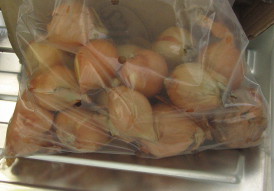One thing that seems to preoccupies us even more than ever, is the weather. Rather than global warming, we seem to be confronted by erratic weather patterns – more of a climate change. Several nights in October were the coldest ever recorded yet in the first week in November, parts of the UK are expecting an unseasonal 15 C. The best response for the gardener is to carry on as normal, this is undoubtedly a ‘blip’ it will be freezing again by next week – no wonder the plants are confused!
If you’ve never tried growing garlic, make this the year and plant it now.
Garlic needs light soil, an open sunny site and can be planted from early October to late December. It is better to wait on heavier soils, digging in grit, planting it on ridges or temporarily in pots of loam based compost then transplanting outdoors in spring. They need a period of one to two months from 0-10degC (32-50F) to ensure they produce decent sized bulbs so I’m putting mine in the fridge for a while, just to make sure – who can tell if this winter will be mild or freezing! Make sure the ’blunt’ end is at the bottom and the tip is just below the soil to discourage curious birds from pulling them out. There are ‘hardneck’ and ‘softneck’ varieties, ‘hardneck’s’ are gourmet varieties with fewer larger cloves, but they don’t tend to store well, so most gardeners go for ‘softnecks’.
It is time to plant Autumn varieties of shallots too, I am trying ‘Yellow Moon’ (Suttons – see image) which is resistant to bolting and the traditional AGM variety ‘Jermor’. If you plant garlic and shallots under horticultural fleece, they establish more rapidly, are protected from birds which often pull the bulbs out of the ground and are protected from the worst of the winter weather.
There’s plenty to do in the garden this month, clear leaves regularly from the lawn to stop the grass from dying, raise containers on pot ‘feet’ to prevent waterlogging, cut back cluster flowered and hybrid tea roses back by one third to prevent wind rock. As the leaves start to fall, don’t forget to cover your garden pond with netting, either buy some specifically for the purpose or use your raspberry netting. Peg it firmly around the pond or make a temporary frame of canes and remove the leaves regularly so weight doesn’t damage the netting.
Finally, remember to build your bonfire for ‘Guy Fawkes’ night as late as possible to prevent hedgehogs from taking up residence and use the opportunity to burn any debris that doesn’t compost readily. Woodash from the bonfire can be spread around fruiting trees as it is a good source of potash – younger wood contains higher levels than older boughs. Spread it around them as soon as possible once the ash is cool, there is always a chance that it will rain – wet wood ash is difficult to move and dry as soon gets blown around by the wind. Alternatively, mix the ash into your compost heap.



